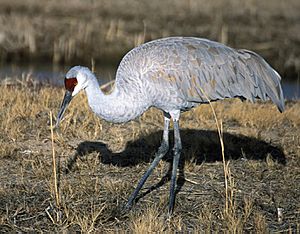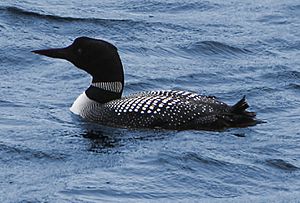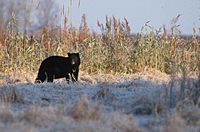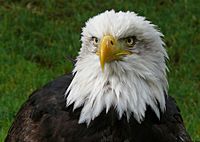Anishinaabe clan system facts for kids
The Anishinaabe people, like many other groups who speak Algonquian languages in North America, have a special way of organizing their families. This system is based on clans or totems, which are passed down through the father's side of the family. The Ojibwe word for clan is doodem, and this word was borrowed into English as "totem." These clans, often named after animals, were very important for traditional jobs, how different tribes got along, and even who people could marry. Today, your clan is still a big part of being Anishinaabe.
Contents
Traditions and Clans
The Anishinaabe people are divided into many doodeman, or clans. Each clan is usually named after an animal totem. In the Anishinaabemowin, the word ode' means "heart." So, doodem means something like "the expression of one's heart" or "your extended family."
According to old stories, the Anishinaabe lived near the Atlantic Ocean. Great Miigis beings came out of the sea. They taught the Mide way of life to the Waabanakiing peoples. Six of these seven great Miigis beings stayed to create the odoodeman (clans) for the people in the east.
The first five Anishinaabe totems were:
- Wawaazisii (the bullhead fish)
- Baswenaazhi (the echo-maker, which is the crane)
- Aan'aawenh (the pintail duck)
- Nooke (the tender one, which is the bear)
- Moozwaanowe ("little" moose-tail)
These clans created a way for the people to have strength and order. Each totem had a main area of knowledge and responsibility for society. Today, there are six main totems that form this system:
- The Crane and the Loon are like the chiefs. They are in charge of leading the people.
- The Fish are the thinkers and scholars. They help solve problems between the crane and loon leaders.
- The Bear are strong warriors and also gather medicines.
- The Martens are hunters and also warriors.
- The Moose are skilled craftspeople and artists.
Clans help the Anishinaabe learn and remember important knowledge. Experiences and lessons learned from spirits and other clan members are passed down through generations. This helps build on what people already know.
In the past, each community had a council. This council was made up of leaders from the different clans. Often, the community was known by its main clan. When two Ojibwe people met, a traditional greeting was "What is your doodem?" (Aaniin odoodemaayan?). This helped them understand their family connection. People from the same clan are not allowed to marry each other.
What the Word Means
The word odoodem is a special kind of noun. When an Anishinaabe person talks about their own doodem, they would say nindoodem(-ag) (meaning 'my clan(s)'). If they are talking to you, they would say gidoodem(-ag) ('your clan(s)'). When talking about someone else, they would say odoodeman ('his/her clan(s)').
The clan system is a very important way for the Anishinaabe to learn and keep knowledge. Each clan adds a key part to society. Individual members add to their clan's knowledge through their own experiences.
Throughout a clan member's life, they learn what their clan already knows. There is a strong focus on personal experience, not just a teacher telling you things. Even though members learn from others in their clan, it's the experience they gain that truly helps them get knowledge. Any new knowledge a clan member discovers is added to the clan's shared wisdom. This knowledge then goes to future generations, like a "flow of Nebwakawin (wisdom) that passes from generation to generation."
Even with challenges from colonial societies in Canada and the United States, much Anishinaabe knowledge has survived. It continues to be shared and built upon. Books like Alexander Wolfe's Earth Elder 18 Stories: The Pinayzitt Path and Edward Benton-Banai's The Mishomis Book: The Voice of the Ojibway are important examples. These books carry knowledge from ancestors to future generations.
Clan Totems
There were at least 21 Ojibwe totems recorded by William Whipple Warren. Other people, like John Tanner, listed fewer but different types of doodem. For the Potawatomi, at least 15 different totems were recorded. Today, there are many clan types, but usually only a few odoodeman are found in each Anishinaabe community.
Like other Algonquian groups, the Anishinaabe clan system was a way of governing and dividing work. The five main groups, or phratries, are listed below. Each group lists the doodem clans within it. The known Algonquin clans are marked with (Al), Mississauga clans with (Ms), Nipissing clans with (Ns), Ojibwa clans with (Oj), Odawa clans with (Od) and Potawatomi clans with (Po).
Bimaawidaasi Group
The Bimaawidaasi group was responsible for scouting, hunting, and gathering food.
- "Hooves" subdivision:
- Moozwaanowe ("Little" Moose-tail) (Oj)
- Moozens or Moozoons or Moozonii (Little Moose)
- Mooz (Moose) (Od, Oj)
- Adik (Caribou) (Al, Ms, Oj, Od) — The Adik totem is common among the Ojibwa and Oji-Cree north of Lake Superior. A well-known family from this clan moved from Grand Portage to La Pointe. They produced chiefs like Mamongazeda and Waubojeeg. Later, members of this family became leaders at Sault Ste. Marie.
- Waawaashkeshi (Deer) (Al, Ms)
- Mishewe (Elk) (Oj, Po)
- Bizhiki (Buffalo) (Ms)
- "Little Paws" subdivision:
Giishkizhigwan Group
The Giishkizhigwan group was responsible for teaching and healing.
- Giigoonh or Namens (Fish)
- Mikinaak (Snapping turtle) (Oj)
- Mishiikenh (Mud turtle) (Oj, Po)
- Miskwaadesi (Painted turtle) (Oj)
- Ginebig (Snake) (Ms, Oj)
- Omazaandamo (Black snake) (Od)
- Midewewe or Ozhiishiigwe (Rattle snake), or Zhiishiigwaan (Rattle) (Al, Od)
- Omakakii (Frog) (Po)
- Nigig (Otter) (Ms, Od)
- Nibiinaabe (Merman)
- Ashaageshiinh (Crab) (Po)
Nooke Group
The Nooke group was in charge of defense and healing. Today, all Bear Clans have joined into one called Nooke. But long ago, the Bear clan was so big that it was divided into parts like the head (Makoshtigwaan or 'bear-skull'), the ribs, and the feet (Nookezid or 'tender-foot'). There were also different types of bears, like the Waabishki-makwa or 'white black bear' and the Mishimakwa or 'grizzly bear'.
- Makwa (Bear) (Ms, Oj, Od, Po)
- Makoshtigwaan (Bear-skull)(Oj)
- Nookezid (Tender-foot)(Oj)
- Makokon (Bear's Liver) (Ms)
- Miskwaa'aa (Blood) (Ns)
- Waabishki-makwa (White black bear)(Oj)
- Mishimakwa (Grizzly bear)(Oj)
- Bizhiw (Lynx) (Oj, Od)
- Ma'iingan (Oj) or Mawii'aa (Po) (Wolf)
Baswenaazhi Group
The Baswenaazhi group was traditionally responsible for talking with other tribes and nations. Because of this, members of the Baswenaazhi group are often known for being very good at speaking.
- Binesi (Thunderbird)
- Ajijaak(we) (Crane or "Thunder") (Ms, Oj, Od, Po)
- Nesawaakwaad ("Forked tree") (Od)
- Ashagi (Heron) (Ns)
- Gekek (Hawk) (Oj, Od)
- Omigizi(we) (Bald eagle) (Ms, Oj, Od, Po)
- Mitigomizh (White oak) (Ms)
- Wiigwaas (Birch bark) (Ms, Ns)
- Giniw (Golden eagle) (Po)
- Bibiigiwizens (Sparrowhawk)(Od)
- Makade-gekek(we) (Black hawk) (Po)
- Ajijaak(we) (Crane or "Thunder") (Ms, Oj, Od, Po)
Bemaangik Group
The Bemaangik group was in charge of communication within the community. They often helped lead community meetings and discussions about local issues.
- Bineshiinh (Bird)
- Aan'aawenh, Aa'aawenh or Aa'aawe (Pintail) (Oj)
- Owewe (Wild goose or "Swan")
- Bine (Partridge or "turkey") or Aagask (grouse) (Oj, Po)
- Nika (Goose) (Ms, Oj)
- Maang (Loon) (Al, Oj, Od, Po)
- (Makade)Zhiishiib ((Black) duck) (Oj)
- Gayaashk (Gull) (Oj, Od)
- Jiwiiskwiiskiwe (Snipe) (Oj)
- Omooshka'oozi (Bittern) (Oj)
- Zhedeg (Pelican)
- Ogiishkimanisii (Kingfisher) (Al, Oj)
- Aandeg (Crow) (Po)
- Gaagaagishiinh (Raven)
- Omiimii (Pigeon) (Ms)
- Apishi-gaagaagi (Magpie) (Ms)
Metaphors for Clans
Sometimes, instead of using the animal's actual name, a clan is called by a metaphor. This metaphor describes a special quality of the clan's totem. The metaphors still used today include:
- Bimaawidaasi 'Carrier' = Amik(we) 'Beaver'
- Giishkizhigwan 'Cut-tail' = Maanameg 'Catfish'
- Nooke 'Tender' = Makwa 'Bear'
- Baswenaazhi 'Echo-maker' = Ajijaak(we) 'Crane'
- Bemaangik 'Pass-by Sounder' = Owewe 'Wild goose'
Social Order and Clans
Some groups of people were simply known by their main clan. For example, the Maandawe-doodem ('Fisher-clan') of the Meshkwahkihaki people lived along the south shore of Lake Superior. Further inland were the Waagosh-doodem ('Fox clan') of the Meshkwahkihaki, who are called the Fox Tribe in English.
When the Maandawe were defeated in a big battle with the Ojibwe, the remaining Maandawe people were adopted into the Ojibwa nation. They became part of the Waabizheshi-doodem ('Marten clan'). Among some Ojibwe people, the Waabizheshi clan can also mean a form of adoption. For example, if a non-Native father and an Ojibwe mother have children, the children might be assigned to the Marten clan.
In other cases, odoodem communities like the Amikwaa were seen as independent nations within the Anishinaabeg Confederacy. Or they were given a name that showed their main role in society. Examples include the Manoominikeshiinyag ('Ricing-rails') or the Waawaashkeshi-ininiwag ('Deer[-clan] Men').
Some doodem names show that the clan originally came from non-Ojibwe people. Besides Waabizheshi, these include the Ogiishkimanisii-doodem (Kingfisher Clan) and Ma'iingan-doodem (Wolf Clan) for Dakota people. The Migizi-doodem (Eagle Clan) is for people with American ancestors. Other odoodem are rare today among the Ojibwa because they have moved into other tribes. An example is the Nibiinaabe-doodem (Merman Clan), which appears as the Water-spirits Clan of the Winnebagoes.
Family Connections
The Ojibwe way of understanding kinship (family connections) is detailed. It includes not just your immediate family but also your extended family. It's a type of kinship system where some family members are grouped together.
For example, Ojibwe people talk about their grandfather (nimishoomis) and grandmother (nookomis). They also have words for father (noos) and mother (ningashi), and son (ningozis) and daughter (nindaanis). But they also have specific terms for:
- Elder brother (nisayenh)
- Younger sibling (nishiimenh)
- Cross-uncle (nizhishenh)
- Parallel-aunt (ninooshenh)
- Male sibling of the same gender (niikaanis)
- Female sibling of the same gender (niidigikoonh)
- Sibling of the opposite gender (nindawemaa)
- Cross-cousin of the opposite gender (niinimoshenh)
Siblings usually share the same term with parallel-cousins. This is because they are all part of the same doodem. However, younger siblings can share the same kinship term with younger cross-cousins (nishiimenh). The system becomes simpler as you move away from your own generation. But some complexity remains with female relatives. For example, ninooshenh means 'my mother's sister' or 'my father's sister-in-law' (my parallel-aunt). It can also mean 'my parent's female cross-cousin'.
For great-grandparents and older generations, and for great-grandchildren and younger generations, the Ojibwe call them all aanikoobijigan. This shows how the Anishinaabe believe in being connected and balanced between all living generations, and all generations from the past and future.
Besides the Anishinaabeg doodem, clans from other tribes are considered related if they have the same name. So, for example, a marriage between an Anishinaabe Bear Clan member and a Cherokee Bear Clan member would be seen as forbidden by many traditional community groups.
Notable Clan Members
White Crane
The White Crane clan members were the traditional chiefs of the Ojibwe at Sault Ste. Marie and Madeline Island. They were some of the most powerful chiefs met by the first French explorers of Lake Superior. Members of the Crane clan include:
- Tagwagane – an important chief at Madeline Island in the early 1800s.
- Ikwesewe – the wife of Michel Cadotte and the person Madeline Island is named after.
Loon
The Loon clan is closely connected to the Crane clan. Members of the Loon clan became important chiefs on the south shore of Lake Superior during the fur trade period. Members of the Loon clan include:
- Chief Buffalo – a famous chief of Madeline Island.
- Walter Bresette – an activist from the Red Cliff Ojibwe.
Bear
The Bear clan has always been the largest among the Anishinaabeg. Traditionally, its members were the warriors and police (Ogichidaa), as well as healers. Many members of the clan continue these roles today. The Bear clan provided most of the people who took part in the Bad River Train Blockade. In books, the police officers in the novels by Louise Erdrich come from the Bear clan.
Eagle
Today, the Eagle clan is one of the most common clans. But it used to be one of the smaller ones. The number of Eagle totem members grew when new members whose fathers were Americans were assigned to this totem. When the Anishinaabe first had regular contact with the United States, it was often through government officials. So, the symbol of the American eagle was chosen as a clan marker. Members of the Eagle clan include:
- William Whipple Warren – an Ojibwe historian from the 1800s.
- Nahnebahwequa – a Mississauga Ojibway missionary and spokeswoman.
- Kahkewaquonaby – a Mississauga Ojibway Methodist missionary and spokesman.
- Anton Treuer – a Leech Lake Band Ojibwe historian and language activist.
See Also
Images for kids






